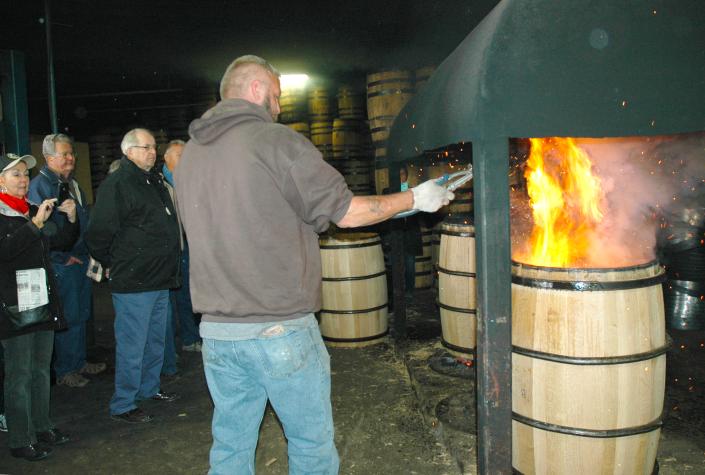COLUMBIA, Mo. – Many of the world’s finest wines and whiskeys begin in Missouri’s hardwood forests.
University of Missouri Extension forester Hank Stelzer shared Missouri’s role in wine and spirit production during the recent White Oak, Whiskey & Wine tour. Due to popular demand and positive reviews, Stelzer plans to make it an annual event.
Tourgoers visited the Rudolf Bennitt Conservation Area at the junction of Boone, Howard and Randolph counties to see a white oak forest. “True white oaks are the preferred species to make barrels, but chinkapin and swamp white oaks also may be used,” Stelzer says. “Other oak trees do not possess the unique cellular features that make white oak barrels leakproof.”
Missouri grows more white oaks than any other state. However, the Show-Me State’s forests and woodlands also contain many undesirable species, Stelzer says. Proper “weeding of the woodland garden” allows white oak seedlings to become mature trees.
The path from forest to barrel is a long one. It takes at least 80 years to grow an American white oak tree to a marketable size. Stelzer says white oak stave logs represent only about 10 percent of timber harvested in any timber sale. The rest goes to grade lumber, flooring, railroad ties, pallets and blocking.
Craftsmen cut logs lengthwise into four bolts at the stave mill. They saw the stave bolts into flat, “quarter-sawn” stave blanks. Heading bolts used to make the top and bottom of the barrel are cut from larger-diameter logs or stave blanks that had to be shortened due to defects.
Stave and header blanks for wine barrels air dry for 24 to 36 months. This allows the sun, wind and rain to break down the tannins in the wood. It also mellows oak in a way that kiln drying cannot. Staves used in whiskey barrels usually dry for 30 to 40 days and finish in a dry kiln.
Tour stops also included The Oak Cooperage and Barrel 53 in Higbee, population 551. Oak Cooperage artisans have produced 59-gallon oak wine barrels since 1972. More than half of its barrels go to Napa Valley for Silver Oak Winery’s prized Cabernet Sauvignon. They also produce American and French oak barrels for the whiskey and bourbon industries.
Barrel 53 is a family-owned enterprise that makes whiskey and wine barrels. It operates a stave mill that processes white oak logs from nearby woodlands. Barrel 53 also recently opened its own distillery. Tourgoers watched artisans create barrels from aged white oak staves and headers. The most crucial step in barrel making is the raising. An artisan assembles narrow staves into a temporary steel ring to hold the staves in place.
To make the staves pliable, artisans place the raised barrel over an open fire or pass it through a hot steam tunnel. They cinch the wide end with a cable and add a second temporary steel ring to give the barrel its final shape.
At The Oak, the barrel’s inside is heated to a specific temperature to impart a light, medium or dark “toast” to the wood according the winery’s exact specifications. This produces the “roasted” aroma in wine. Toasting also enhances the presence of vanillin and creates smoky and spicy notes similar to the oil of cloves.
At Barrel 53, visitors watched as barrels for freshly distilled “white dog” whiskey were charred or burned on the wood’s surface. The charcoal acts like a filter and reacts with the sharp substances of the white dog. Intense heat during charring forms a caramelized layer from natural sugars in the wood. This layer creates the bourbon’s amber color and caramel and butterscotch flavors. During aging, the whiskey expands into the wood during hot months and returns into the barrel during cold months to add color and flavor to the spirits.
But before that complex chemical dance begins, the final steps of the coopering process must occur. A groove is milled into the inside ends of cooled barrels. Headers are placed in these grooves. Galvanized metal hoops replace the temporary hoops. Wine barrels are sanded smooth for appearance.
The last steps are to add the bunghole—the entrance and exit for wine or whiskey—and check for leaks. The bunghole goes on the side of the barrel in the middle of a wide stave. After drilling, workers put water into the barrel and rotate it so the water touches all staves. Artisans pressurize the barrel to check for bubbles, which indicate leaks. Defective barrels go back to the most experienced coopers for repair.
Following lunch in Higbee, the tour traveled to Les Bourgeois Vineyards at Rocheport to learn how the winery uses Missouri white oak barrels. The family-owned vineyard is a tourist destination overlooking the Missouri River near Interstate 70. It is Missouri’s third-largest winery, producing more than 120,000 gallons of wine each year, including native cultivars such as Missouri’s state grape, Norton, along with French hybrid grapes and the newest, Chardonel.
Gary Hinegardner of Wood Hat Spirits at New Florence explained how he uses Missouri white oak barrels and locally grown heritage corn to create unique whiskeys and cordials. Hinegardner says Wood Hat is the first craft distillery in Montgomery County and the only wood-fired still in the country. He prefers toasted barrels to bring out subtle flavors. “Six hundred dollars’ worth of whiskey comes from a $3 bushel of corn,” he said. “That’s what I call value-added.”
